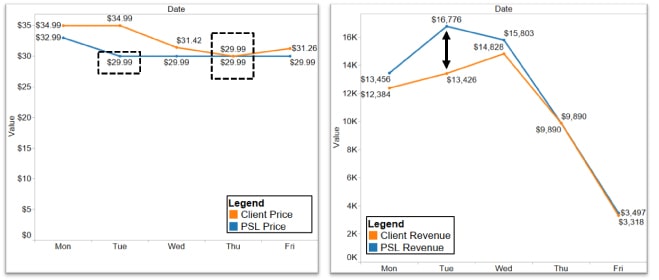6%
Margin Improvement
48%
Reduction in Material Waste
The Challenge
Extracting maximum profit dollars from perishable items is complex. If prices are too high, items go unsold and eventually get wasted, increasing the cost of materials. If prices are too low, product inventory gets depleted too fast and sales potentially lost, sub-optimizing revenues and profits.
In addition to this dilemma, the business was facing another challenge. Most of its SKUs were, in fact, part of multiple offerings (e.g. the same chocolate box was offered in multiple gift baskets). As a result, prices of each individual SKU (e.g. the chocolate box) needed to be optimized based on supply and demand for multiple products (e.g. the multiple gift baskets).
E-Commerce
E-commerce sites have become a popular destination for shopping, as more and more customers choose the convenience of online retailers over traditional brick-and-mortar stores. Despite such high demand, digital stores need to constantly re-evaluate their pricing strategy in order to remain competitive.
Our client was a major e-commerce retailer in the US, specialized in flowers and gift baskets. Their pricing strategy was a combination of cost-plus (margin-driven) approach and daily adjustments based on changes in inventory, given the perishable nature of their products. The Pricing Solutions team leveraged advanced modeling skills to develop a dynamic pricing model that optimized prices daily based on forecasted demand and supply (inventory). The model was able to generate a 6% margin improvement over current practice for the client.
Building a Solution that Fits
To help the client achieve their pricing objectives, Pricing Solutions undertook a three steps process to develop a new dynamic pricing model that optimized prices daily for the client. These included:
- Designing the Analytical Model
- Conducted extensive review of the academic literature on dynamic pricing
- Developed a dynamic pricing model based on:
- Supply: daily levels of inventory for each SKU
- Demand: machine learning model estimating price elasticity daily
- Iterative feedback between supply and demand
- Generated optimized daily prices, refreshed every night
- Scaling and Testing the Dynamic Model
- The original model was built and stress-tested for a single SKU
- The dynamic pricing model was then expanded to include all SKUs within a given category
- The model was then thoroughly tested on past and live data
- Implementing Price Recommendations
- A daily data feed of sales and inventory was created to refresh the model every night and generate optimized prices every morning
- The Pricing Solutions team conducted a final meeting with the client to deliver the dynamic pricing model as well as the final recommendations on the pricing strategy

Left chart: A price comparison between the client’s actual prices and Pricing Solutions’ recommended prices for a selected flower for a selected week (Monday-Friday)
Right chart: A comparison between daily revenue using the client’s actual prices and using Pricing Solutions’ recommended prices for a selected flower for a selected week (Monday-Friday)
The Result?
Based on Pricing Solutions’ dynamic pricing model, the client was able to optimize their product pricing daily, approaching equilibrium between customer demand and product inventory. For the test category, the dynamic model was able to generate a 6% margin improvement over current pricing practices. The improvement was driven by a simultaneous increase in revenue (through more reactive pricing) and decrease in costs via a 48% reduction in material waste.
The Pricing Solutions Difference
Building an effective dynamic pricing model for an e-commerce platform can be challenging, especially for perishable products. In order to optimize profit, the business needs to accurately determine how demand will be impacted by a change in price in order to maximize the revenue of a given level of inventory.
By leveraging transactional data, cutting edge statistical analysis and deep pricing expertise, Pricing Solutions was able to develop a unique dynamic pricing model for the client that addressed a critical business challenge and generated significant profit for the company.




